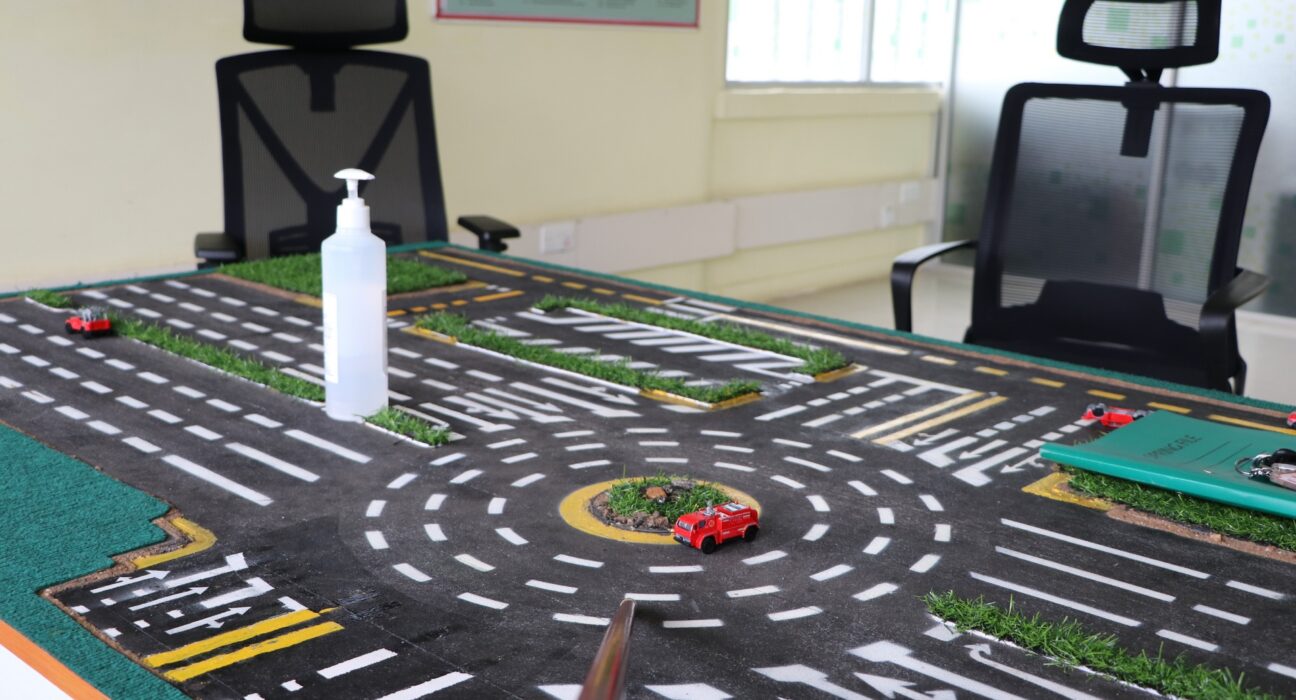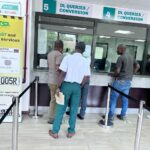In Kenya, obtaining a driving license is a significant milestone, but the journey to earning one involves navigating the National Transport and Safety Authority (NTSA) driving exam, a rigorous test of both practical and theoretical skills. A critical component of the NTSA theory exam is the Model Town Board (MTB), a miniature representation of Kenya’s road network designed to assess a learner’s understanding of road rules, traffic signs, and navigation. For aspiring drivers in 2025, mastering the Model Town Board is non-negotiable to ace the NTSA driving test and become a safe, competent driver on Kenyan roads.
This article dives deep into the 10 signs of a Model Town Board that every learner must understand to excel in the NTSA driving exam. We’ll also provide actionable NTSA driving exam tips tailored for Kenyan learners, drawing from credible sources like driving school manuals, NTSA guidelines, and expert insights. Whether you’re preparing for your test in Nairobi, Mombasa, or Kisumu, this guide will equip you with the knowledge and confidence to succeed. Let’s explore the key features of the Model Town Board and how to tackle its challenges effectively.
What is the Model Town Board?
The Model Town Board is a scaled-down replica of a typical Kenyan road network used in driving schools to teach learners how to navigate roads, intersections, and traffic scenarios. It includes features like roundabouts, parking zones, pedestrian crossings, and road signs, mimicking real-world driving conditions in towns like Nairobi or Eldoret. During the NTSA driving exam, learners are tested on their ability to maneuver a toy car on the board while adhering to traffic rules, demonstrating lane discipline, and responding to examiner instructions.
Understanding the 10 signs of a Model Town Board is crucial because they form the backbone of the NTSA theory test. Examiners assess your ability to interpret these signs, follow road rules, and make safe driving decisions. Let’s break down these signs and pair them with practical tips to help you pass your NTSA driving exam in 2025.
The 10 Signs of a Model Town Board
1. One-Way Traffic Road (Dual Carriageway)
A one-way traffic road on the Model Town Board represents a dual carriageway where all vehicles move in the same direction. These roads are common in urban areas like Nairobi’s Uhuru Highway.
- Key Features:
- Marked with white continuous or broken lines dividing lanes.
- Continuous white lines indicate no lane changes or overtaking.
- Broken white lines allow overtaking if the road is clear.
- A yellow kerb on the left protects the green field, prohibiting parking or stopping.
- NTSA Exam Tip: When navigating a one-way road, always stay in the correct lane (usually the leftmost unless overtaking). During the exam, verbally state your actions, e.g., “I’m staying in Lane 1 as it’s a one-way road.” Practice identifying broken versus continuous lines to avoid errors.
2. Two-Way Traffic Road (Single Carriageway)
Two-way traffic roads simulate roads where vehicles travel in opposite directions, such as rural roads in Kenya or sections of Thika Road.
- Key Features:
- Marked with a single yellow continuous or broken line at the center.
- Continuous yellow lines mean no overtaking.
- Broken yellow lines allow overtaking if safe.
- NTSA Exam Tip: Always check for oncoming traffic before overtaking on a two-way road. In the exam, demonstrate caution by pausing at junctions and stating, “I’m checking both directions before proceeding.” Familiarize yourself with the yellow line rules to score points on road discipline.
3. Roundabout
The roundabout is a central feature of the Model Town Board, representing busy intersections like those at Westlands or Nyali.
- Key Features:
- Vehicles move clockwise around a central island.
- No stopping, parking, or overtaking is allowed within the roundabout.
- Vehicles entering must yield to those already in the roundabout.
- NTSA Exam Tip: Practice lane discipline when approaching a roundabout. For example, use Lane 1 for left turns or going straight, and Lane 3 or 4 for right turns. Verbally announce, “I’m yielding to vehicles from the right,” to show awareness of the right-of-way rule.
4. Angle Parking Zone
Angle parking zones simulate parking areas in Kenyan towns, such as shopping malls or office complexes.
- Key Features:
- Designed for small cars, requiring forward parking from the farthest slot.
- Exit by reversing carefully.
- Often located near main roads, requiring right-of-way checks.
- NTSA Exam Tip: During the exam, park the toy car in the farthest slot and state, “I’m parking in the last slot as per angle parking rules.” Check for main road traffic before exiting, as examiners prioritize safety awareness.
5. Parallel Parking Zone
Parallel parking zones mimic street parking scenarios, common in busy areas like Kenyatta Avenue.
- Key Features:
- Vehicles park in reverse, starting from the last slot.
- Exit by driving forward.
- Suitable for most vehicles except tractors and trailers.
- NTSA Exam Tip: Practice reverse parking smoothly on the Model Town Board. Announce, “I’m reversing into the last parallel parking slot,” to demonstrate clarity. Avoid hitting other toy cars or kerbs, as precision is key.
6. Stop Sign
The stop sign is an eight-sided red sign with white letters, found at junctions joining two-way roads.
- Key Features:
- Requires a complete stop.
- Drivers must check both directions (right, left, right) before proceeding.
- NTSA Exam Tip: Always stop at a stop sign and verbalize, “I’m stopping and checking both directions.” This shows adherence to safety protocols, a critical exam component.
7. Give Way/Yield Sign
The give way sign is a red triangular sign with a white border, indicating priority to other vehicles.
- Key Features:
- Drivers must slow down or stop if necessary.
- Proceed only when the road is clear.
- NTSA Exam Tip: When encountering a give way sign, say, “I’m slowing down to yield to oncoming traffic.” Practice identifying this sign quickly, as it’s often tested randomly.
8. Pedestrian Crossing (Zebra Crossing)
Pedestrian crossings are marked areas where vehicles must stop for pedestrians, common in Kenyan urban centers.
- Key Features:
- Marked with white stripes.
- Vehicles must stop if pedestrians are crossing.
- NTSA Exam Tip: Pause at zebra crossings and state, “I’m stopping for pedestrians.” This demonstrates road safety awareness, a key scoring criterion.
9. Road Markings (Arrows, Reflectors, Delta Marks)
Road markings guide traffic flow and lane discipline on the Model Town Board.
- Key Features:
- Arrows indicate permitted directions (e.g., straight, left, right).
- Delta marks guide vehicles at junctions or roundabouts.
- Reflectors enhance visibility.
- NTSA Exam Tip: Follow road markings precisely. For example, if an arrow indicates a left turn, stay in the correct lane and announce, “I’m following the left arrow in Lane 1.” Misinterpreting markings can lead to point deductions.
10. Central Road Reserve
The central road reserve separates lanes on dual carriageways, often seen on highways like Mombasa Road.
- Key Features:
- Marked with double yellow lines or a physical barrier.
- Indicates no crossing or overtaking.
- NTSA Exam Tip: Avoid crossing the central reserve unless at designated U-turn points. State, “I’m staying within my lane due to the central reserve,” to show rule adherence.
NTSA Driving Exam Tips for Model Town Board Success
To excel in the NTSA driving exam in 2025, preparation and practice are key. Here are actionable tips to help you master the Model Town Board and pass with confidence:
- Study the NTSA Learner’s Manual: The official NTSA manual covers road signs, rules, and Model Town Board features. Read it thoroughly to understand Kenyan traffic laws.
- Practice with Online Platforms: These platforms offer interactive tests to boost familiarity.
- Enroll in an NTSA-Accredited Driving School: Schools provide structured lessons on the Model Town Board. Listen to instructors and ask for feedback.
- Verbalize Your Actions: During the exam, explain your actions clearly (e.g., “I’m stopping at the zebra crossing” or “I’m yielding at the roundabout”). This demonstrates confidence and understanding.
- Master Lane Discipline: Practice staying in the correct lane, especially at roundabouts and junctions. For example, use Lane 1 for left turns and Lane 3 for right turns.
- Prioritize the Shortest Route: Always choose the shortest, most correct route unless instructed otherwise. If parking is required, use it as a last resort.
- Stay Calm Under Pressure: Examiners may test your composure by asking rapid questions or changing scenarios. Stay relaxed and focus on safety.
- Practice Parking Techniques: Master both angle and parallel parking, as these are common exam tasks. Practice reversing smoothly to avoid errors.
- Understand Right of Way: Always yield to vehicles with priority, such as those already in a roundabout or on the main road.
- Review Common Questions: Familiarize yourself with frequently asked questions, such as “What is the most important rule of the Model Town Board?” (Answer: Always use the shortest route.)
Common Mistakes to Avoid on the Model Town Board
Even well-prepared learners can make errors during the NTSA driving exam. Here are common pitfalls and how to avoid them:
- Ignoring Road Signs: Failing to recognize stop or give way signs can lead to immediate failure. Memorize all signs and their meanings.
- Poor Lane Discipline: Switching lanes incorrectly or not following arrows can cost points. Practice lane changes in a controlled environment.
- Forgetting to Verbalize: Examiners rely on your explanations to assess understanding. Always state your actions clearly.
- Rushing Through Scenarios: Speeding through the board without checking for traffic or pedestrians shows recklessness. Pause and assess each situation.
- Incorrect Parking: Parking in the wrong slot or failing to check for traffic when exiting can lead to deductions. Follow parking rules strictly.
Preparing for the NTSA Driving Exam in 2025
Beyond the Model Town Board, the NTSA driving exam includes practical driving and road sign identification. Here’s how to prepare holistically:
- Book Your Test Early: Use the NTSA TIMS portal to schedule your exam at a convenient location, such as the Industrial Area office in Nairobi.
- Practice Practical Driving: Hone skills like three-point turns, U-turns, and reversing in real-world conditions. Drive in varied settings, like rainy weather or busy streets, to build confidence.
- Review Road Signs: Expect to identify at least three random road signs during the exam. Use resources like Muthurwa.com’s digital driver notes for comprehensive sign lists.
- Conduct Vehicle Checks: Before the practical test, demonstrate pre-drive checks (e.g., mirrors, tires, lights). This impresses examiners and shows preparedness.
- Stay Updated on NTSA Guidelines: Check NTSA’s official website or social media for 2025 updates on exam formats or rules.
The NTSA driving exam is a challenging but achievable step toward earning your Kenyan driving license. By mastering the 10 signs of a Model Town Board—from one-way roads to pedestrian crossings—you’ll build a strong foundation for both the theory test and real-world driving. Combine this knowledge with consistent practice, verbal clarity, and a calm demeanor, and you’ll be ready to impress NTSA examiners in 2025.





